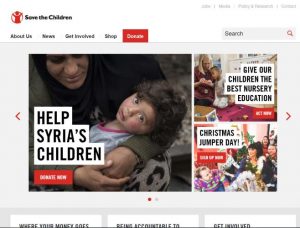What does your charity’s website currently focus on? There’s a good chance that it has priorities like this:
a. Explaining what the charity does
b. Showing the charity’s work in a good light
c. Encouraging people to get involved (donors, volunteers, etc)
Speak TO your audience, instead of ABOUT your charity
I hate to break it to you, but your reader doesn’t really want to know about your charity. They want to know why THEY will feel good if they engage with your charity.
A core marketing principle is to emphasise benefits to your audience, rather than features of your organisation. So a MUCH higher-impact approach is:
1. Inspire people to get involved (donors, volunteers, etc – in the specific ways you’d like them to get involved)
2. Promote your charity’s brand
3. Explain what your charity does (and this definitely does need to be there)
This shift in emphasis can be as simple as saying ‘Your donation can give a homeless person a warm bed for the night” instead of “We run a night shelter for the homeless.”
It may feel uncomfortable to move informational content a bit lower down the agenda. But without 1 & 2, why would anyone need 3?
Calls to Action
Meanwhile, the engagement you’re seeking from your readers starts at the level of maybe reading a few words on your website and getting a positive impression of your charity.
So once you’ve got their attention, it’s vital to include Calls to Action which explicitly encourage further engagement – “Donate now,” “Read more,” “Volunteer today.”
The Marketing Funnel
As their engagement grows, they might feel moved share a page of the site with their friends, like your Facebook page, make a donation, or think about volunteering.
A core marketing goal is to help encourage them further into this ‘marketing funnel.” Your site wants to be nudging them along a path of ever-increasing engagement.
So, 8 charity websites with strong marketing messages
These successful charities are applying these marketing principles really well, right from the top of their home pages.
Cancer Research UK
Calls to Action
“Share your story #cancerRightNow” (Participate in a Cancer Research UK social media campaign)
“Donate right now”
“Fundraise right now”
“Volunteer right now”
Benefits to the reader
“Let’s beat cancer sooner”
They’re saying: your actions can make a difference to ending cancer.
You personally can do something about the plight of people like the poor baby in the photo.
Smiles all round
And they’re making this a good news story. Everyone in the photos is smiling.
There are two images of smiling women, which generally have good marketing impact.
Shelter
Call to Action
“Donate now”
Benefits to the reader
“You can help change this” (meaning the plight of the homeless children)
“Your donation could make the difference between making up on Christmas morning in a hostel or in a home.”
They’re saying: if you take this action, you can feel you personally are making a huge difference to people worse off than yourself.
It’s about you, not them
They’re talking about you, the reader. They’re looking to inspire you, to the action of making a donation.
They’re NOT telling you a list of all the valuable charitable activities they undertake.
We can see that someone who knows something about marketing has helped put this together.
RSPB
Calls to Action
“Create a cosy hedgehog home” (Engage in a practical activity which is aligned with the RSPB’s mission.)
On the page that this links to, there are fun instructions on how to build a hedgehog home, and further Calls to Action encouraging you to buy a related kit, or to get involved in a ‘personal plan’ of RSPB activities.
Benefits to the reader
The next line down, just off the bottom of my screenprint, says “Together we can give nature the home it needs.”
They’re saying: if you take this action, you will receive the benefits of feeling you are doing something practical to help nature. Plus you’ll be having fun and engaging with something cute.
This is really nice because it’s got a light touch. They’re not beating you around the head with the plight of our wildlife. Endangered species, habitat loss, climate change, doom doom doom. Instead they’re drawing you into the idea of doing something fun. They’re promoting your sense of agency – you CAN do something, it’s not all hopeless.
Drawing you gently into their marketing funnel
And then whether you just read the article (like I just did), or you go ahead and actually build a hedgehog shelter, you’re going to have the RSPB and its good work at the front of your mind for a while. You’re going to be absorbing a message related to their mission (hedgehogs are a part of our natural world that need our conservation help). You’re going to be gently creeping forward through the RSPB’s marketing funnel.
For good measure, it’s also the kind of thing that should get shared really well on social media – cute animal image, uplifting message, fun activity for kids, etc.
I’m looking at their site in autumn, so I guess this is seasonal and they probably have all different content here at the top of their site at different times. For the small charities I generally work with, frequent home page updates wouldn’t usually be practical, but that doesn’t mean your site can’t still incorporate a lot of the great marketing practice that the RSPB are showcasing here.
Oxfam
Calls to Action
“Run, bake, tweet, give, shop, speak out, even sky dive” (Nice! Sounds like fun!)
Then the green drop down arrow in the middle reveals this list:
“Volunteer for Oxfam”
“Run a marathon”
“Remember Oxfam in my will”
“Donate to Oxfam”
“Donate to an Oxfam shop”
“Spread the word on Twitter”
“Follow Oxfam on Facebook”
“Join Oxfam’s giant mosaic”
Benefits to the reader
“We can’t do it without you”
“How will you be part of the generation to end extreme poverty?”
They’re saying: if you take one of these actions, you personally can feel indispensable to helping to end world poverty. And you can have fun, and have a sense of personal agency, while doing it. What’s not to like?
I have to say I particularly like this one. They’re taking a subject that could be flat-out grim – grinding poverty in parts of the developing world.
And against the odds, they’re creating an inspiring vision of how I personally could meaningfully do something about that. And it feels like it would be FUN! Really nicely done.
RSPCA
Calls to Action
“Show neglected animals some love this winter“
“Get involved“
“Shop online“
Benefits to the reader
“Love animals / Hate cruelty“
“Will you help show your love for animals? “
“Could you offer a forever home to an animal that desperately needs it? “
“Support our vital animal welfare work“
They’re saying: taking one of these actions is in alignment with your values or love towards animals and concern with animal welfare. Your personal contribution can help animals, either directly or indirectly.
Truthfully, I braced myself a bit before opening this, in case it was all full of animal cruelty. I’m as much of an animal lover as the next middle aged woman.
But I was pleased to see that, while they’re clear that this is part of what they’re working against, they’re not trying to beat the reader around the head with it. They’re using positive messaging rather than trying to horrify you, or guilt you, in to giving. Phew. Well done them.
Help for Heroes
Calls to Action
“Shop now”
“Donate now“
Benefits to the reader
“You can change someone’s life today”
“Together, rebuilding lives”
They’re saying: if you take these actions, your help can make the difference to a hero’s life.
That’s a powerful message. Who wouldn’t want to do that?
‘You’ language
As an aside, another aspect of good marketing practice that these sites are using is plenty of ‘you’ language. They’re using straightforward language directly to you the reader. They’re avoiding abstract, bureaucratic, jargon heavy or overly formal language.
For example, ‘You can change someone’s life today.”
They don’t say “Strongly positive outcomes for members of our beneficiary group are achieved daily by the ongoing delivery of relevant services by our dedicated volunteer base.”
Save the Children
Calls to Action
“Help Syria’s children“
“Donate now“
“Give our children the best nursery education“
“Act now“
“Sign up now“
Benefits to the reader
“Help Syria’s children“
“Give our children the best nursery education“
They’re saying: if you take one of these actions, you personally can help children, at home and abroad. You can feel like you are making a difference.
Salvation Army
Calls to Action
“Donate now”
“Read more”
“Get involved”
Benefits to the reader
“Your gift will ensure we’re there for those who need us this Christmas”
“Spare a little time and make a huge difference in your community by volunteering for us”
“Your donation this Christmas could help us be there for vulnerable people like Jenny”
They’re saying: if you “donate” or “get involved” or even just “read more” you personally can help transform someone’s Christmas, specifically a real person like Jenny, and it can even be quick and easy for you.
This definitely looks seasonal (!) so if it’s now not Christmastime, why don’t you click the link and have a look at what they’ve got up now. Can you identify their current Calls to Action? Can you see the benefits they’re offering you?
A not so subtle difference
It’s funny because the difference between talking ABOUT your organisation (“Our volunteers befriend older people in Cirencester”) versus offering a BENEFIT to the reader (“Share the gift of company with one of Cirencester’s seniors”) might not seem like a big deal. It may seem like two ways of saying the same thing that are hardly any different.
But the marketing impact of the latter is soooo much better! If your charity’s website is full of what your charity DOES, then your site will support your charity a lot better if you switch the language over to what it has to OFFER to the reader.
Great charities, great marketing
OK wow, that was a marathon post! Thank you for sticking with me.
So my point is, these sites are actively taking advantage of good marketing practice. Is there anything sinister about this? No! I love it.
Is there anything bad taste about it? Not at all. These sites are well presented, avoiding heavy emotional manipulation, guilt trips, insulting the beneficiaries, or making crass demands. They are offering encouragement. They are respectfully inviting you the reader to make a difference if you would like to.
These are great charities, doing good work. They’re making sure their marketing comes up to the same standard as everything else they do.
Why? To do their level best, across the board, to really deliver on their mission, to respect the contributions of their supporters, and to support the needs of their beneficiaries.
Getting your charity’s marketing really working for you
Are you ready to get your charity’s website working this powerfully for you?
Just get in touch to get started.








